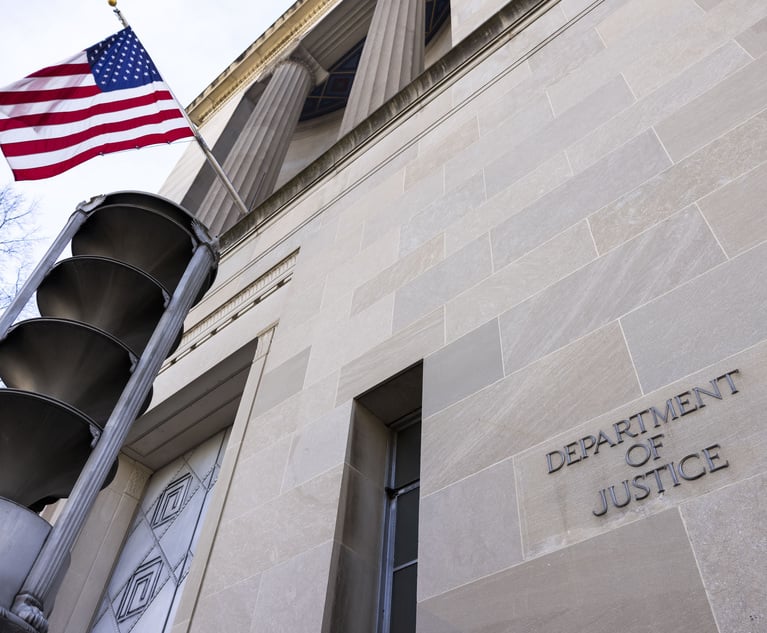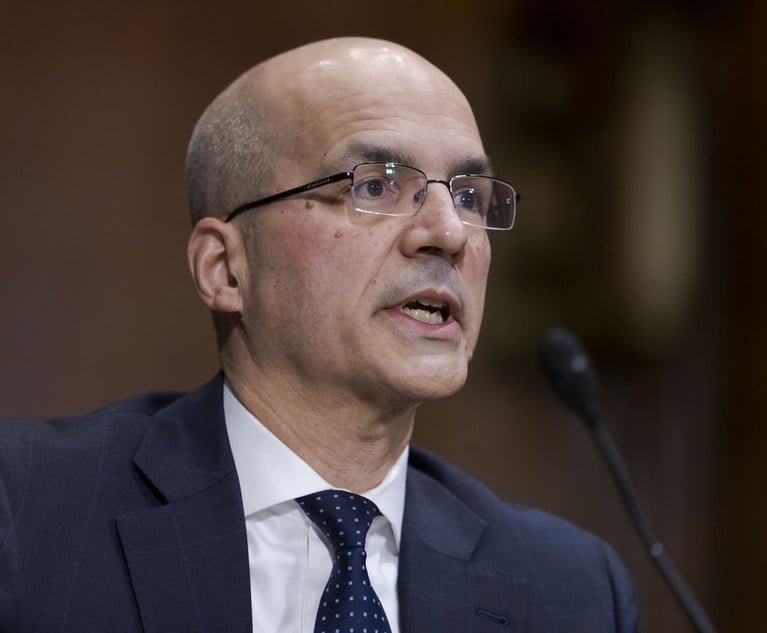The Wisdom of Using AI for Middle Value Arbitration Disputes
In the current environment where global conditions challenge multiple business relationships at once (i.e., across jurisdictions or a global supply chain), companies are likely to face a number of middle-value disputes and will require thoughtful dispute resolution techniques to resolve them in a cost-effective manner. It is here that AI may offer the most promise.
June 05, 2020 at 11:30 AM
8 minute read
 Client service in the legal profession is changing. Indeed, in the post-COVID-19 world, extraordinary change and the ability to adapt to that change has ruled the day. But, even before we were called upon to live virtual lives and make the most of technology to service and meet the novel needs of clients, there was increasing pressure in the marketplace to deliver better, more efficient legal services. In the area of dispute resolution, the costs of resolving disputes have continued to increase largely driven by the exponential increase in the amount of data involved. Add to that the complexities of dealing with that data over borders, and corollary discovery expenses, and costs skyrocket. Indeed, for some smaller value cases, counsel might even pass altogether on bringing forward a valid claim. In a recent University of Queen Mary survey focused on construction arbitration, 43% of in-house counsel believed that disputes needed to be valued between $11 million to $25 million to make the claims worth pursuing. With decreased liquidity in global markets and shrinking corporate budgets, businesses face even more complicated analyses to determine which disputes are "essential" or "non-essential" to take forward.
Client service in the legal profession is changing. Indeed, in the post-COVID-19 world, extraordinary change and the ability to adapt to that change has ruled the day. But, even before we were called upon to live virtual lives and make the most of technology to service and meet the novel needs of clients, there was increasing pressure in the marketplace to deliver better, more efficient legal services. In the area of dispute resolution, the costs of resolving disputes have continued to increase largely driven by the exponential increase in the amount of data involved. Add to that the complexities of dealing with that data over borders, and corollary discovery expenses, and costs skyrocket. Indeed, for some smaller value cases, counsel might even pass altogether on bringing forward a valid claim. In a recent University of Queen Mary survey focused on construction arbitration, 43% of in-house counsel believed that disputes needed to be valued between $11 million to $25 million to make the claims worth pursuing. With decreased liquidity in global markets and shrinking corporate budgets, businesses face even more complicated analyses to determine which disputes are "essential" or "non-essential" to take forward.
In the meantime, machine-learning technologies have found their way into virtually every business sector. Artificial Intelligence (AI) is transforming industries from health care to transportation. Although the legal profession has been somewhat resistant, AI applications have marched their way into the practice of law, and some have argued that current global conditions will only accelerate their widespread use. So what is AI exactly? Simply put, AI is highly advanced software that utilizes statistics, pattern matching and coding to perform tasks. It appears to think like a human, but is "smarter," in that it can use and maintain volumes of data that no human could. Current uses of AI technologies in the law range from "chat-bots" acting as a first point of contact to use of predictive coding for document review to elementary decision-support systems for simple commercial disputes. While these uses are growing, the question is whether AI can do more.
Up until now, the arbitration community has responded to some of the cost-benefit problem raised above by developing expedited provisions that seek to streamline proceedings. These improvements have been largely focused on lower-value, lower-complexity disputes. But, what about the middle value dispute? One can argue about what would constitute a middle value dispute but at its core, it might be a dispute that is moderately complex, or where the potential costs of bringing the action are significant considering the amount and interests at issue. In the current environment where global conditions challenge multiple business relationships at once (i.e., across jurisdictions or a global supply chain), companies are likely to face a number of these disputes and will require thoughtful dispute resolution techniques to resolve them in a cost-effective manner. It is here that AI may offer the most promise.
Why AI Can Disrupt Middle Value Arbitration Disputes
Although arbitration prides itself on eschewing the type of scorched-earth discovery considered common-place in U.S. litigation, it is hard to get around the fact that disputes today involve more data. There is likely to be a significant volume of data that parties and their counsel need to wade through to even begin to assess whether they have a case. We are already using AI technology to categorize, process and evaluate such data, but more complex tasks are possible. For example, predictive coding (also known as technology assisted review or TAR) uses AI to learn and make better decisions while significantly expediting the document review process. Predictive coding starts by training software with a sample set of data and then using continuous active learning builds on that data set with the help of computer-driven algorithms. The value of predictive coding has already been endorsed in U.S. courts, including by then-U.S. Magistrate Judge Andrew Peck in Da Silva Moore v. Public Group (where the court held that predictive coding helps secure the just, speedy, and inexpensive determination of lawsuits).
AI can also provide cost-effective data security at scale, by selecting or cordoning out documents most likely to contain protected personal, financial or health information requiring higher levels of privacy protection and attention. Other possible cost-efficiencies include the ability to translate thousands of documents with very high accuracy. In international proceedings where disputes are often conducted in one language, but underlying transaction or project documents are conducted in another, this can result in considerable cost and time savings.
Other useful applications of AI that could change the game focus on the use of data analytics to better predict outcomes, starting with the process of selecting the arbitrators themselves. One of the unique features of arbitration is the ability to select, or at least have a role in the selection, of the ultimate decision-maker. There has been a great deal of focus on making information about potential arbitrators more widely available. Companies such as Arbitrator Intelligence have sought to crowd-source, aggregate and make more objective data available. Other companies have started to collect data regarding the length, time, and other features of commercial arbitrations. (One analysis tool relies on Bayesian machine learning (ML), which relies on reasonable or educated guesses of an event happening. This may offer advantages over other models, where due to the confidential nature of arbitration, there is a limited amount of non-confidential data.) It is not hard to see the immediate benefit of analyzing this data, including the ability to better assist parties (and counsel) in identifying arguments they believe arbitrators may be more receptive to. At the same time, the more data that is available, the more parties will be better able to evaluate their chances of success. This may help to take emotion or bias out of the equation that might impede an objective assessment or possible settlement.
Finally, we have seen AI programs that seek to assist or augment the work done by arbitrators themselves. For example, machines powered by AI might be able to draft standard sections of awards. And there has been some suggestion that AI might be going even further, with the computer perhaps deciding the outcome of the dispute itself. Online dispute resolution systems (ODRs) have been most frequently been seen in smaller scale consumer disputes for large corporations such as Alibaba, Amazon, and eBay, but is also a tool increasingly being utilized by various governments to widen access to justice.
Risks and Limitations
With all of the potential upside of using AI, why is there resistance? In short, it is not a panacea. Limitations of AI use center around what computers cannot do and inherent blind-spots. No matter how "intelligent" a machine is, it does not have essential human characteristics: compassion, discretion, judgment, or a sense of equity. These are characteristics that we have come to expect in our advocates and arbiters. Further, despite the better brain that AI might provide to catalog or discern patterns, it cannot enable computers to reason. Therefore, a machine is unsuited to process intangible concepts such as good faith, reasonableness, or materiality.
Predictive analysis has other limits too. AI technology can be expensive and therefore difficult for infrequent users to invest in them. Moreover, while it can assist with repetitive fact-patterns and binary outcomes, it is less useful where there are novel factual circumstances and claims.
Algorithms are further limited by the four V's of big data: Volume, Variety, Velocity and Veracity.
The "Volume" challenge is that AI needs sufficient non-confidential case data. Because arbitration awards are typically unpublished and confidential, this can be a stumbling block. The "Variety" challenge relates to source or content of data. If the data provided is repetitive and simple, for example, how will the computer program be able to deal with a non-repetitive or complex fact pattern? The "Velocity" problem deals with the frequency of incoming or new data. Since AI models are extracted from previous data, they are ill-equipped to deal with sudden policy changes. The "Veracity" issue deals with risk of bias and trustworthiness of the data being used. While some may assume that AI models have the advantage of algorithmic objectivity, the fact is, computer models are only as good as the input data. Therefore, if the underlying data reflects human biases, those biases will be embedded in future outcome prediction. The unintentional use of incomplete and inaccurate data by AI can thus perpetuate inequitable results.
Conclusion
There can be no doubt that AI is now poised to change the game for dispute resolution. With its freedom from cognitive limitations, AI has enabled a technological revolution, multiplying our capabilities in ways once never thought possible. Advanced uses are around the virtual corner. Outside and inside counsel alike should be looking to AI to unlock value. By partnering together, utilizing shared technology resources, we can change the value proposition of the middle dollar value arbitration dispute.
Tomasita Sherer and Kiera Gans are of counsel in the litigation, arbitration and investigations group at DLA Piper.
This content has been archived. It is available through our partners, LexisNexis® and Bloomberg Law.
To view this content, please continue to their sites.
Not a Lexis Subscriber?
Subscribe Now
Not a Bloomberg Law Subscriber?
Subscribe Now
NOT FOR REPRINT
© 2025 ALM Global, LLC, All Rights Reserved. Request academic re-use from www.copyright.com. All other uses, submit a request to [email protected]. For more information visit Asset & Logo Licensing.
You Might Like
View All
'A Shock to the System’: Some Government Attorneys Are Forced Out, While Others Weigh Job Options
7 minute read
'Serious Legal Errors'?: Rival League May Appeal Following Dismissal of Soccer Antitrust Case
6 minute read
How Some Elite Law Firms Are Growing Equity Partner Ranks Faster Than Others
4 minute read
Law Firms Mentioned
Trending Stories
- 1DeepSeek Isn’t Yet Impacting Legal Tech Development. But That Could Soon Change.
- 2'Landmark' New York Commission Set to Study Overburdened, Under-Resourced Family Courts
- 3Wave of Commercial Real Estate Refinance Could Drown Property Owners
- 4Redeveloping Real Estate After Natural Disasters: Challenges, Strategies and Opportunities
- 5Calif. Fires Should Serve as a Reminder to Fla.’s Commercial Landlords and Tenants Not to Be Complacent
Who Got The Work
J. Brugh Lower of Gibbons has entered an appearance for industrial equipment supplier Devco Corporation in a pending trademark infringement lawsuit. The suit, accusing the defendant of selling knock-off Graco products, was filed Dec. 18 in New Jersey District Court by Rivkin Radler on behalf of Graco Inc. and Graco Minnesota. The case, assigned to U.S. District Judge Zahid N. Quraishi, is 3:24-cv-11294, Graco Inc. et al v. Devco Corporation.
Who Got The Work
Rebecca Maller-Stein and Kent A. Yalowitz of Arnold & Porter Kaye Scholer have entered their appearances for Hanaco Venture Capital and its executives, Lior Prosor and David Frankel, in a pending securities lawsuit. The action, filed on Dec. 24 in New York Southern District Court by Zell, Aron & Co. on behalf of Goldeneye Advisors, accuses the defendants of negligently and fraudulently managing the plaintiff's $1 million investment. The case, assigned to U.S. District Judge Vernon S. Broderick, is 1:24-cv-09918, Goldeneye Advisors, LLC v. Hanaco Venture Capital, Ltd. et al.
Who Got The Work
Attorneys from A&O Shearman has stepped in as defense counsel for Toronto-Dominion Bank and other defendants in a pending securities class action. The suit, filed Dec. 11 in New York Southern District Court by Bleichmar Fonti & Auld, accuses the defendants of concealing the bank's 'pervasive' deficiencies in regards to its compliance with the Bank Secrecy Act and the quality of its anti-money laundering controls. The case, assigned to U.S. District Judge Arun Subramanian, is 1:24-cv-09445, Gonzalez v. The Toronto-Dominion Bank et al.
Who Got The Work
Crown Castle International, a Pennsylvania company providing shared communications infrastructure, has turned to Luke D. Wolf of Gordon Rees Scully Mansukhani to fend off a pending breach-of-contract lawsuit. The court action, filed Nov. 25 in Michigan Eastern District Court by Hooper Hathaway PC on behalf of The Town Residences LLC, accuses Crown Castle of failing to transfer approximately $30,000 in utility payments from T-Mobile in breach of a roof-top lease and assignment agreement. The case, assigned to U.S. District Judge Susan K. Declercq, is 2:24-cv-13131, The Town Residences LLC v. T-Mobile US, Inc. et al.
Who Got The Work
Wilfred P. Coronato and Daniel M. Schwartz of McCarter & English have stepped in as defense counsel to Electrolux Home Products Inc. in a pending product liability lawsuit. The court action, filed Nov. 26 in New York Eastern District Court by Poulos Lopiccolo PC and Nagel Rice LLP on behalf of David Stern, alleges that the defendant's refrigerators’ drawers and shelving repeatedly break and fall apart within months after purchase. The case, assigned to U.S. District Judge Joan M. Azrack, is 2:24-cv-08204, Stern v. Electrolux Home Products, Inc.
Featured Firms
Law Offices of Gary Martin Hays & Associates, P.C.
(470) 294-1674
Law Offices of Mark E. Salomone
(857) 444-6468
Smith & Hassler
(713) 739-1250






